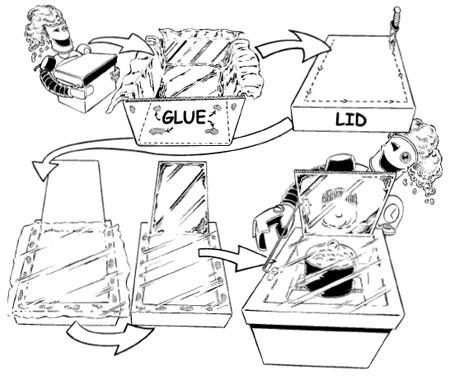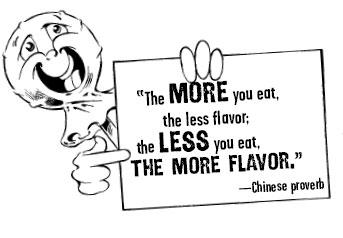When All Hell Breaks Loose (76 page)
Read When All Hell Breaks Loose Online
Authors: Cody Lundin



Like anything new, solar-oven operation takes a little getting used to. Sometimes it's necessary to move them a couple of times to make the most of the shifting sun, and during very windy days, the one featured in the photo section will blow over unless it's anchored down. Where you live will depend on how often you can use your oven throughout the year.
Cooking Tips and Techniques for Getting the Most Fuel Bang for Your Buck
All fuel sources after an emergency will be like gold. Whether it's gasoline or firewood, its presence is like money in the bank for the savvy survivor. Knowing how to make these precious resources stretch is all-important.
The efficiency of a heat source used for cooking can be thought of as having three parts. The first part is the
efficiency of combustion of the fuel
and the second is
the efficiency of heat transfer to the cooking container
. The third variable is the
competence and skill of the person doing the cooking
. Over all, maximizing the second variable will result in the greatest fuel savings. Use the techniques listed below
now
to save energy and get yourself accustomed to doing more with less.
Many of the following tips can be incorporated into cooking over a campfire as well. Outdoor campfires will be under the influence of weather variations and require much greater attention to variable number one when compared to a premixed propane-fueled stove that's used indoors.
Choose a good pot!
Broad-bottomed pots are better than narrow ones. Thick metal takes more time to heat up but also holds and radiates more heat when the heat source is removed. Pots with short handles on either side, as opposed to one long handle, will be easier to incorporate into a hay box (featured next). Your pot must have a lid.
Keep a lid on it!
Hot air rises. Food cooks much slower in a pot without a lid, thus it uses the same amount of fuel but for a much longer duration. The same amount of heat enters the pot but less of it is used for the cooking process, hence an uncovered pot is a less successful heat exchanger. Lids should be tight fitting to keep the steam inside the pot. Lids can be insulated by putting several layers of aluminum foil in or on the lid. When the lid becomes hot, turn down the burner but keep the lid on.
Wear a skirt!
Use a noncombustible, reflective skirt of double or tripled layers of heavy-duty aluminum foil or unpainted, ungalvanized aluminum roof flashing to encircle the cooking flame and pot, reradiating otherwise lost heat toward the sides of the pot. This increases the heat transfer value for the same amount of fuel. The skirt can be as tall as the pot on the stove with about half an inch to a quarter of an inch of clearance away from the sides of the pot. Double up the material encircling the pot a few inches and anchor it with a large metal paper clip. Some folks simply put a large metal mixing bowl upside down over the entire cooking pot.
Shorten the distance!
Keep the cooking container as close as possible to the heat source without suffocating the flame from receiving oxygen.
Keep the heat focused!
Flame blasting up around the edges of a pot is wasted. Turn the burner down until the flame is focused upon the middle of the pot, yet covering as much surface area as possible. Smaller flames may take longer to cook but will yield greater cooking results for the fuel consumed. Doing so will also eliminate much burnt food stuck to the bottom of the pot, thereby saving food and washing time.
Center the pot directly over the cooking flame!
This sounds like common sense but check out where the pot is located tonight at dinner. Ninety percent of the time it's off to one side of the flame.
The Hay Box: The Power of Heat-Retained Cooking
Precious fuel creates the heat that is then used to cook your food. But what if you could harness the heat from the food in your pot to do some of its own cooking? Doing so would allow you to turn off the stove that much sooner, thereby maximizing limited fuel resources. This heat-retention cooking concept is exploited to its fullest by using something which is commonly referred to as a
hay box
. A hay box is nothing more than a superinsulated box in which food that has been heated to cooking temperature is placed to continue cooking. Its fuel savings, depending on the type of food and how much cook time it requires, can be from 20 to 80 percent! The longer a food item takes to cook on the stove, the greater the savings when using an insulated cooker. Insulated cookers can be used anytime, not just after emergencies, to save a tremendous amount of cooking fuel and energy.
The concept behind insulated cookers is simple. When food in a container is put near a heat source, the food climbs to the boiling temperature and then stabilizes. The food within the stabilized temperature then "cooks" for a given period of time. Any heat beyond the boiling temperature is merely replacing heat lost to the surrounding environment by the pot. When the container reaches its top temperature and then is removed from the heat source and placed in a superinsulated box, the food inside continues to cook. In heat-retained cooking, food is brought to a boil, simmered for a few minutes depending on the particle size of the food, and then put into the hay box to continue cooking. (Simmer smaller grains such as rice for five or six minutes. Simmer larger food such as dried beans or whole potatoes for fifteen to eighteen minutes. Presoaking and draining beans always makes them easier to cook, as well as to digest. Red meats such as a roast can be simmered for twenty to thirty minutes. Note: As a safety precaution, meats should be recooked before serving.) The insulation prevents most of the heat in the food from escaping, thereby eliminating the need for a continued heat source for cooking.
As a general rule, hay-box cooking times are usually one or two times the regular cooking time on a stove. It's like having a free crockpot, cooking the food and keeping it warm, without burning the contents, until you're ready to eat. Like many techniques in this book, experimentation will prove what works best.